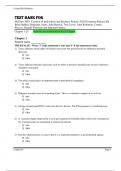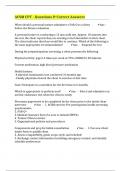Created By Solutions
Test Bank For
McGraw Hill's Taxation of Individuals and Business Entities 2025 Evergreen Release By
Brian Spilker, Benjamin Ayers, John Barrick, Troy Lewis, John Robinson, Connie
Weaver, Ronald Worsham and Edmund Outslay
Chapter 1-25 Answers are at the End of Each Chapter
Chapter 1
Student name:
TRUE/FALSE - Write 'T' if the statement is true and 'F' if the statement is false.
1) Taxes influence many types of business decisions but generally do not influence personal
decisions.
⊚ true
⊚ false
2) Taxes influence business decisions such as where a business should locate or how a business
should be structured.
⊚ true
⊚ false
3) Tax policy rarely plays an important part in presidential campaigns.
⊚ true
⊚ false
4) Margaret recently received a parking ticket. This is a common example of a local tax.
⊚ true
⊚ false
5) George recently paid $50 to renew his driver's license. The $50 payment is considered a tax.
⊚ true
⊚ false
6) A 1 percent charge imposed by a local government on football tickets sold is not considered a
tax if all proceeds are earmarked to fund local schools.
⊚ true
⊚ false
7) One key characteristic of a tax is that it is a required payment to a governmental agency.
⊚ true
⊚ false
Graded A+ Page 1
,Created By Solutions
8) Common examples of sin taxes include the taxes imposed on airline tickets and gasoline.
⊚ true
⊚ false
9) One benefit of a sin tax (e.g., a tax on cigarettes) is that it should increase the demand for the
products being taxed.
⊚ true
⊚ false
10) In addition to raising revenues, specific U.S. taxes may have other objectives (e.g., economic
or social objectives).
⊚ true
⊚ false
11) The two components of the tax calculation are the tax rate and the taxpayer's status.
⊚ true
⊚ false
12) The tax base for the federal income tax is taxable income.
⊚ true
⊚ false
13) A flat tax is an example of a graduated tax system.
⊚ true
⊚ false
14) The main difficulty in calculating an income tax is determining the correct amount of the tax
base.
⊚ true
⊚ false
15) A taxpayer's average tax rate is the most appropriate tax rate to use in tax planning.
⊚ true
⊚ false
16) The effective tax rate, in general, provides a better depiction of a taxpayer's tax burden than
the average tax rate.
⊚ true
⊚ false
17) The effective tax rate expresses the taxpayer's total tax as a percentage of the taxpayer's
taxable and nontaxable income.
⊚ true
Graded A+ Page 2
,Created By Solutions
⊚ false
18) In a proportional (flat) tax rate system, the marginal tax rate will always equal the average
tax rate.
⊚ true
⊚ false
19) In a regressive tax rate system, the marginal tax rate will often be greater than the average tax
rate.
⊚ true
⊚ false
20) A sales tax is a common example of a progressive tax rate structure.
⊚ true
⊚ false
21) In terms of effective tax rates, the sales tax can be viewed as a regressive tax.
⊚ true
⊚ false
22) While sales taxes are quite common, currently the U.S. federal government does not impose
a sales tax.
⊚ true
⊚ false
23) The largest federal tax, in terms of revenue collected, is the Social Security tax.
⊚ true
⊚ false
24) The 9th Amendment to the U.S. Constitution removed all doubt that a federal income tax was
allowed under the U.S. Constitution.
⊚ true
⊚ false
25) A common example of an employment-related tax is the Medicare tax.
⊚ true
⊚ false
26) Self-employment taxes are charged on self-employment income in addition to any federal
income tax.
⊚ true
⊚ false
Graded A+ Page 3
, Created By Solutions
27) Excise taxes are typically levied on the value of a good purchased.
⊚ true
⊚ false
28) The estate tax is assessed based on the fair market values of transfers made during a
taxpayer's life.
⊚ true
⊚ false
29) A use tax is typically imposed by a state on goods purchased within the state.
⊚ true
⊚ false
30) Property taxes may be imposed on both real and personal property.
⊚ true
⊚ false
31) Relative to explicit taxes, implicit taxes are much easier to estimate.
⊚ true
⊚ false
32) Implicit taxes are indirect taxes on tax-favored assets.
⊚ true
⊚ false
33) Dynamic forecasting does not take into consideration taxpayers' responses to a tax change
when estimating tax revenues.
⊚ true
⊚ false
34) The income and substitution effects are two opposing effects that one could consider in static
forecasting.
⊚ true
⊚ false
35) Horizontal equity is defined in terms of taxpayers in similar situations whereas vertical
equity is defined in terms of taxpayers in different situations.
⊚ true
⊚ false
Certainly! Crafting a detailed analysis or overview of a comprehensive tax textbook like "Taxation of Individuals and Business Entities, 2025 Evergreen Release" by Brian Spilker et al., requires a structured approach to cover the breadth and depth of the material. Here’s a detailed breakdown you can
use as a framework for a 5000-word discussion.---### Introduction#### Overview of the Textbook"Taxation of Individuals and Business Entities, 2025 Evergreen Release" is a wid ely recognized textbook authored by a team of esteemed tax professionals and educators: Brian Spilker, Benjamin
Ayers, John Barrick, Troy Lewis, John Robinson, Connie Weaver, Ronald Worsham, and Edmund Outslay. This textbook provides an in-depth examination of the principles, applications, and complexities of taxation as it pertains to both individuals and business entities in the United States. The
2025 Evergreen Release continues the tradition of offering a comprehensive resource that reflects the latest changes in tax legislation, case law, and IRS regulations.### Part 1: Foundations of Taxation#### 1.1 Taxation Principles and FrameworkThe textbook begins by outlining the foundational
principles of taxation. This includes the underlying philosophy of taxation, such as equity, efficiency, and simplicity. It discusses the historical development of the U.S. tax system, emphasizing key legislative milestones and their impact on current tax policy.#### 1.2 Structure of the U.S. Tax
SystemA detailed analysis of the federal tax structure, including the roles of different tax authorities (IRS, Treasury Department) and the various types of taxes imposed (income, estate, gift, and excise taxes), is provided. The book also explores the relationship between federal and state tax systems,
highlighting the interplay and conflicts that can arise.### Part 2: Individual Taxation#### 2.1 Gross Income and ExclusionsThis section dives into the concept of gross income, identifying what constitutes gross income under the Internal Revenue Code. It covers various inclusions and exclu sions,
such as wages, interest, dividends, and fringe benefits, and explains the principles behind each category.#### 2.2 Deductions and CreditsThe textbook provides a comprehensive review of deductions and credits available to individual taxpayers. This includes standard versus itemized deductions,
personal exemptions, and the myriad of tax credits, such as education credits, earned income credit, and child tax credits. The nuances and eligibility criteria for these deductions and credits are discussed in detail.#### 2.3 Tax Computation and LiabilityThe process of computing tax liability is
Graded A+ Page 4





